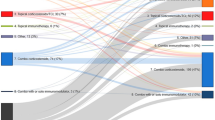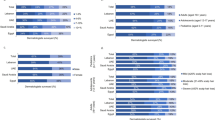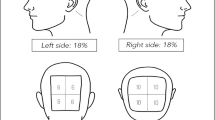Abstract
Alopecia areata is an autoimmune disease that results in partial or total balding of the scalp and/or body. Treatments available are minimally effective, have severe side effects, and are often painful. Given these burdens, patients may not feel undergoing treatment is worthwhile. The purpose of this study is to characterize the willingness of patients with alopecia areata to undergo treatment. We found that few patients are willing to undergo treatment at the risk of severe health side effects. The most acceptable form of treatment administration was topical and the least acceptable was injection at the site of hair loss. A majority of patients would only undergo treatment for hair growth that is cosmetically acceptable and the most important site of hair regrowth was the scalp. The willingness to undergo treatment differed significantly by gender, age, time since disease onset, and disease severity. This study offers insight into the preferences of patients with alopecia areata and characteristics that would make treatment widely acceptable. Institutions conducting research on treatment for alopecia areata can use the results of this study to better understand the needs of their target population.
Similar content being viewed by others

Availability of data and materials
Not applicable.
Code availability
SAS was used for all analysis in this study. Code can be provided upon request.
References
Safavi KH, Muller SA, Suman VJ, Moshell AN, Melton LJ (1995) Incidence of alopecia areata in Olmsted County, Minnesota, 1975 through 1989. Mayo Clin Proc 70:628–633
Mirzoyev SA, Schrum AG, Davis MDP, Torgerson RR (2014) Lifetime incidence risk of alopecia areata estimated at 2.1 percent by Rochester Epidemiology Project, 1990–2009. J Invest Dermatol 134(4):1141–1142
Villasante Fricke AC, Miteva M (2015) Epidemiology and burden of alopecia areata: a systematic review. Clin Cosmet Investig Dermatol 8:397–403
FAQ’s. National alopecia areata foundation. https://www.naaf.org/faqs. Accessed Jan 31, 2020.
Alkhalifah A (2010) Alopecia areata update part I. Clinical picture, histopathology, and pathogenesis. J Am Acad Dermatol 62(2):177–188
Tucker P (2009) Bald is beautiful? The psychosocial impact of alopecia areata. J Health Psychol 14(1):142–151
Schmidt S (2003) Female alopecia: the mediating effect of attachment patterns on changes in subjective health indicators. Br J Dermatol 148:1205–1211
Colón EA, Popkin MK, Callies AL, Dessert NJ, Hordinsky MK (1991) Lifetime prevalence of psychiatric disorders in patients with alopecia areata. Compr Psychiatry 32(3):245–251
Kӧkҫam I, Akyar N, Saral Y, Oǧuzhanoǧlu NK (1999) Psychosomatic symptoms in patients with alopecia areata and vitiligo. Tr J of Medical Sciences 29:471–473
Welsh N, Guy A (2009) The lived experience of alopecia areata: a qualitative study. Body Image 6(3):194–200
Hunt N, McHale S (2005) Reported experiences of persons with alopecia areata. J Loss Trauma 10:33–50
Firooz A, Ghazisaidi B (2005) Concepts of patients with alopecia areata about their disease. BMC Dermatol 5:1
Alkhalifah A, Alsantali A, Wang E, McElwee KJ, Shapiro J (2010) Alopecia areata update: part II. Treatment. J Am Acad Dermatol 62(2):191–202
Ranawaka RR (2014) An observational study of alopecia areata in Sri Lanka adult patients. Ceylon Med J 59:128–131
Amirnia M, Mahmoudi SS, Karkon-Shayan F et al (2015) Comparative study of intralesional steroid injection and cryotherapy in alopecia areata. Niger Med J 56(4):249–252
Chang KH, Rojhirunsakool S, Goldberg LJ (2009) Treatment of severe alopecia areata with intralesional steroid injections. J Drugs Dermatol 8(10):909–912
Charuwichitratana S, Wattanakrai P, Tanrattanakorn S (2000) Randomized double-blind placebo-controlled trial in the treatment of alopecia areata with 0.25% desoximetasone cream. Arch Dermatol 136:1276–1277
Pascher F, Kurtin S, Andrade R (1970) Assay of 0.2% fluocinolone acetonide cream for alopecia areata and totalis. Dermatology 141:193–202
Crispin MK, Ko JM, Craiglow BG et al (2016) Safety and efficacy of the JAK inhibitor tofacitinib citrate in patients with alopecia areata. JCI Insight 1(15):1–10
Liu LY, Craiglow BG, Feng D, King BA (2016) Tofacitinib for the treatment of severe alopecia areata and variants: a study of 90 patients. J Am Acad Dermatol 76(1):22–28
Castelo-Soccio L (2017) Experience with oral tofacitinib in 8 adolescent patients with Alopecia universalis. J Am Acad Dermatol 76(4):754–755
Reid EE, Haley AC, Borovicka JH et al (2012) Clinical severity does not reliably predict quality of life in women with alopecia areata, telogen effluvium, or androgenic alopecia. J Am Acad Dermatol 66(3):e97-102
Textor J, Zander B, Gilthorpe MK, Liskiewicz M, Ellison GTH (2016) Robust causal inference using directed acyclic graphs: the R package ‘dagitty.’ Int J Epidemiol 45(6):1887–1894
Ng KF, Norazirah MN, Mazlin MB, Adawiyah J, Shamsul AS (2017) Psychological impact, self-perception and the contributing factors in patients with androgenetic alopecia. J Cosmo Trichol 3:3
Weitz R (2001) Women and their hair seeking power through resistance and accommodation. Gend Soc 15(5):667–686
Dixson BJW, Rantala MJ (2016) The role of facial and body hair distribution in women’s judgement of men’s sexual attractiveness. Arch Sex Behav 45:877–889
Acknowledgements
Supported by a Research Award from the National Alopecia Areata Foundation.
Funding
Funding was provided by the National Alopecia Areata Foundation.
Author information
Authors and Affiliations
Corresponding author
Ethics declarations
Conflict of interest
The authors have no conflicts of interest to disclose.
Additional information
Publisher's Note
Springer Nature remains neutral with regard to jurisdictional claims in published maps and institutional affiliations.
Supplementary Information
Below is the link to the electronic supplementary material.
Rights and permissions
About this article
Cite this article
O’Connor, L.F., Wells, K.M. Characterizing the willingness to undergo treatment in patients with alopecia areata. Arch Dermatol Res 314, 749–757 (2022). https://doi.org/10.1007/s00403-021-02286-z
Received:
Revised:
Accepted:
Published:
Issue Date:
DOI: https://doi.org/10.1007/s00403-021-02286-z



